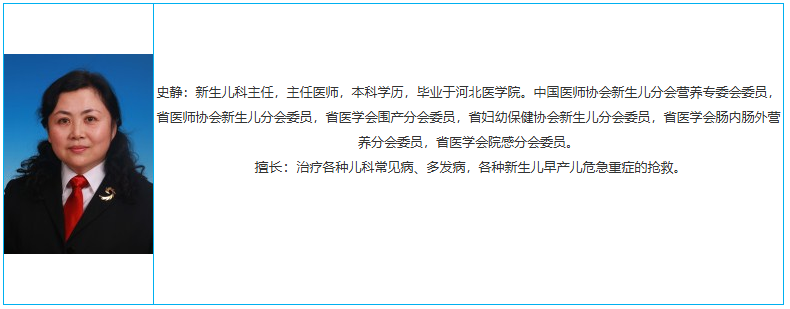- Date:2020-01-08

The Neonatology Department of Liaocheng Second People's Hospital was established in December 2007, which is the earliest independent department in the northwestern part of Shandong Province specialising in the treatment of infants within 28 days of birth. In order to reduce cross-infection and provide a good medical environment for children, the department took the lead in Liaocheng City in 2008 in launching a transparent appearance of the unaccompanied ward. The ward has 30 open beds and 35 medical and nursing staff, including 1 deputy chief physician, 3 attending physicians, 3 residents, 7 nurse practitioners in charge, 14 nurse practitioners and 7 nurses.
In order to ensure the medical safety of children, the unaccompanied ward is equipped with a group of medical and nursing staff who have studied in Peking University Women's and Children's Hospital, Nanjing Children's Hospital, Children's Hospital Affiliated to Hangzhou University, Qilu Hospital, Hospital Affiliated to Binzhou Medical College, etc. They are usually meticulous and conscientious in their work and are highly skilled in their work. It is also equipped with a variety of excellent and complete instruments and equipment, which can meet the needs of all inpatients. The main instruments and equipments are: 12 sets of imported mechanical ventilation ventilators (including transnasal CPAP function), 22 sets of multi-parameter life monitors, 3 sets of radiant warming rescue tables, 56 sets of closed warming boxes, 1 set of transfer warming boxes, 26 sets of micro syringe pumps, 3 neonatal laryngoscopes, 10 neonatal resuscitation airbags, 3 sets of electrically operated negative-pressure suction devices, 20 sets of blue-light therapeutic instrument, 1 set of cold light source jaundice therapeutic instrument, 3 sets of mobile blue-light therapeutic instrument, 3 sets of mobile blue-light therapeutic instrument. There are 20 blue light therapeutic instruments, 1 cold light source jaundice therapeutic instrument, 3 mobile blue light therapeutic instruments, 1 subcooling therapeutic instrument, 8 air-cleaning screens, and at the same time, we are also equipped with percutaneous jaundice measuring instrument and microglucose meter.
Our department mainly treats the following diseases: preterm infants of various gestational weeks, low birth weight infants, very low and ultra-low birth weight infants, neonatal asphyxia, neonatal hypoxic-ischemic encephalopathy, intracranial hemorrhage, bronchopulmonary dysplasia, neonatal apnea, neonatal pneumonia, meconium aspiration syndrome, preterm infants' respiratory distress syndrome, pulmonary hemorrhage, neonates with electrolyte disorders, such as hypoglycemia and hyponatremia, and neonates with neonatal jaundice and microglycemia, hyponatremia, neonatal convulsions, neonatal scleroderma, neonatal jaundice, neonatal hemolytic disease, neonatal hemorrhagic disease, anaemia; all kinds of neonatal infectious diseases: sepsis, diarrhea, neonatal necrotizing small bowel colitis, impetigo, multiorgan failure and other critically ill children, pediatric surgery and other perioperative children for postoperative monitoring and life support. At the same time, the department undertakes the transfer and treatment of critically ill newborns from Linqing, Linxi, Qinghe, Xazin and other neighbouring areas.
The medical and nursing team of our department is highly skilled, conscientious and meticulous. In addition to completing a large number of heavy daily work, we have also carried out the following work, all of which are at the leading level in China: respiratory support therapy for preterm infants, alveolar surface active substance replacement therapy for preterm infants, nasal continuous positive airway pressure (nCPAP) and nasal intermittent positive pressure ventilation (nIPPV), volume-protected ventilation, high-frequency shock ventilation, parenteral nutrition, umbilical venous cannulae for preterm infants, central venous catheter (PACC) insertion by peripheral venous puncture. The management of enteral nutrition for preterm infants has been gradually strengthened since 2013, and the individualised enteral nutrition programme for preterm infants has been continuously improved. Breastfeeding for hospitalised preterm infants, bedside ultrasonography, regular post-discharge follow-up, and home-based nursing wards have been actively carried out. The above comprehensive treatment measures have greatly increased the success rate of rescue of preterm infants and very low birth weight infants in our department, and more than 1,000 critically ill newborns are successfully rescued each year, which is well received by all sectors of the society. In the process of treating the premature quadruplets in 2014, the whole department made concerted efforts, dedication and bold innovation, and the four surviving children were successfully treated and discharged from the hospital, which really demonstrated the spirit of ‘first-class work, first-class service, first-class performance, first-class team’ of our department, and won a good reputation for the hospital and social effects.
In recent years, all the medical and nursing staff of our department have also summarized their work experience, and published more than 30 academic papers in national magazines and core journals such as Chinese Journal of Paediatrics, Chinese Journal of General Practice, Clinical Journal of Practical Paediatrics, Journal of Neonatology, Chinese Primary Care Medicine, Chinese Paediatric Emergency Medicine, etc., and have carried out 14 scientific research achievements, of which 10 were awarded the Progress Prize for Scientific and Technological Achievements of Liaocheng City, and completed 16 national patents. He has completed 16 national patents and written 9 professional treatises. Our department has been rated as an advanced group by the hospital for several years, and has won the ‘Departmental Progress Award’, ‘Advanced Group for Women and Children's Work in Linqing City’, and ‘Pioneer Post for Female Workers and Staff in the City’. ‘The department is determined to become a leading centre for women's healthcare in China. Our department aspires to become a regional neonatal treatment centre in northwestern Shandong Province, providing more safe, standardized and efficient services for more newborns.




 鲁ICP备11009722号-4
鲁ICP备11009722号-4 